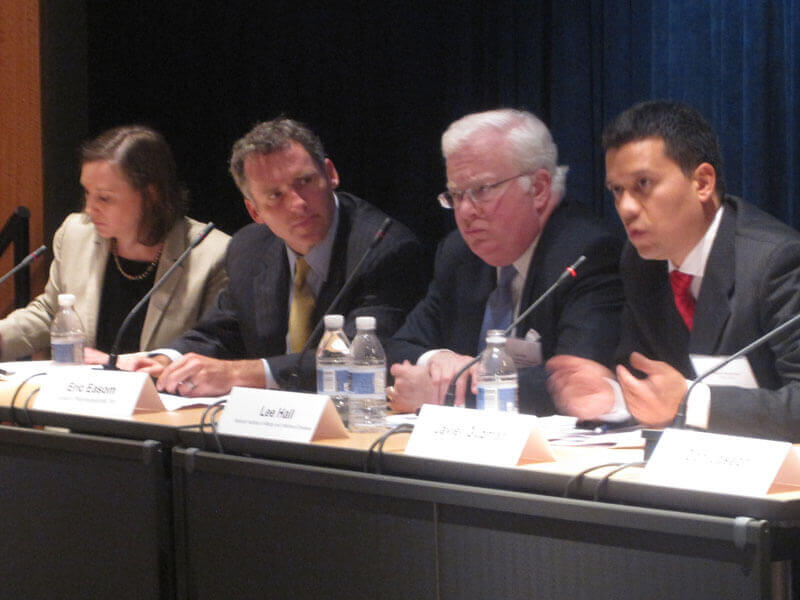Kim LufkinGHTC
Kim Lufkin is a communications officer at GHTC.
With the ever-present specter of federal budget reductions that could impact global health and development programs, the GHTC’s event on Friday to launch our new report couldn’t have come at a better time. The report, released by the GHTC and Policy Cures, provides new and exciting data on US investments over the past 10 years in global health research and development (R&D). It confirms that support from the US Government and its federal agencies has not only contributed to the largest pipeline of new global health products in history, but also that these investments make smart economic sense domestically.
Dr. Javier Guzman, director of research at Policy Cures, shared the report’s main findings at Friday’s event, which was co-hosted by Research!America. Guzman outlined that the US Government has contributed significantly to global health R&D—indeed, the United States is the largest funder of R&D efforts worldwide, contributing $12.7 billion from 2000 to 2010. This support has translated into the largest pipeline of new global health drugs, vaccines, diagnostics, and other products, over half of which are supported by the United States. The US Government “needs to keep this momentum going” because “investments in global health R&D really work,” Guzman said.
Guzman also stressed a key theme that emerged during the event—that of partnerships. According to Guzman, critical partnerships have formed between the US Government and the active global health R&D community that has emerged over the past ten years. This community includes philanthropic organizations, the pharmaceutical and biotechnology industries, academic institutions, and non-profit groups. The success of these partnerships can be seen in the development and delivery of new health tools like the Xpert ® MTB/RIF test for tuberculosis (TB), which Guzman said is projected to save 100,000 lives every year in India alone.

Dr. Lee Hall—chief of the Parasitology and International Programs Branch at the National Institute of Allergy and Infectious Diseases (NIAID)—also spoke about the importance of partnerships to his branch at the National Institutes of Health. According to Hall, partnerships between NIAID and academic institutions, industry, endemic country governments, and global organizations are “essential” to translating research into effective products. And Heather Ignatius, senior manager for policy at the Global Alliance for TB Drug Development, stressed that product development partnerships (PDPs) like her organization rely on collaboration with philanthropic organizations such as the Bill & Melinda Gates Foundation, which is currently the top funder of PDPs worldwide, as well as governments and industry groups.
Additionally, the panelists emphasized how supporting R&D for new global health tools ultimately benefits the United States. Hall discussed how when President Roosevelt dedicated the NIH in 1940, he identified global health as a priority for the agency. “What perhaps started for humanitarian reasons also has benefits for the US,” Hall said, adding that better health products are needed in this era where infectious diseases know no borders. Guzman also shared how global health R&D creates jobs for Americans and boosts the economy. In 2007, for example, federal support for global health R&D paid $540 million in wages for employees in California. And Eric Easom, program leader for neglected diseases at the California biotechnology company Anacor Pharmaceuticals, reinforced this point when he said that conducting global health R&D allows his company to provide jobs for talented researchers and employees who “truly care about this work. It’s the reason we got into this business in the first place.”
Finally, speakers addressed how continued support for research to develop new global health products has the potential to make an enormous impact across the globe. When discussing Anacor’s partnership with the Drugs for Neglected Diseases initiative to develop a new treatment for sleeping sickness, Easom said that the drug candidate is an “innovation that could totally change the game for patients” with the disease. Ignatius emphasized how the US Government must continue its support for global health R&D, and provide increased support for mechanisms like PDPs—much in line with the report recommendations. “We’re on the verge of developing and delivering drastically improved tools. They won’t get there if we can’t finish these final stages of testing,” she said, adding, “Donors must scale up their commitments, and we need increased involvement from the US Government. Now is the time.”